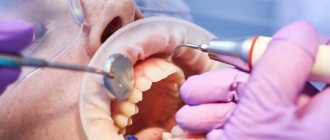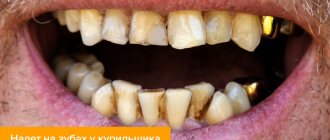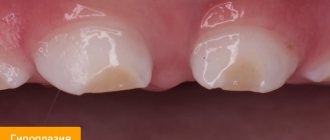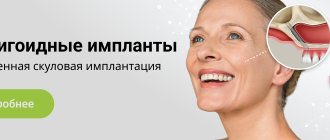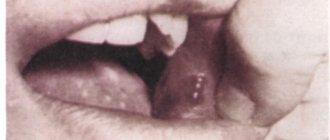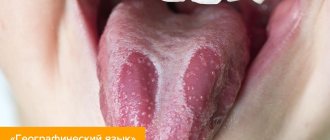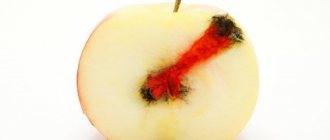How does coffee affect enamel?
If you doubt whether coffee makes teeth yellow, look at the structure of the tooth. The enamel has pores where microparticles of coffee grounds penetrate. Because of this, dark spots appear. But some people have a smooth surface on their teeth. No staining deposits settle on their enamel and they can drink their favorite drink without harm.
Plaque on teeth from coffee is not only an external problem. As it accumulates, it begins to harden and turns into tartar. And this already leads to the appearance of periodontitis.
How is plaque formed?
First, soft plaque forms on the teeth, the formation of which consists of three stages:
- A couple of minutes after the end of cleaning the oral cavity, active reproduction and spread of bacteria throughout the oral cavity begins. The process takes 4 hours, after which the number of bacteria reaches a million.
- Over the next 3 hours, the bacteria attach to the surface of the tooth enamel and form a soft film. After fixation, microorganisms begin to release substances that destroy the enamel, causing carious lesions to develop.
- When 8 hours have passed after cleansing the oral cavity, deposits become visible and structured. The majority of bacteria in them do not require oxygen.
The resulting film progressively thickens and becomes denser. hard plaque forms within a day after the last brushing. The formation of tartar is typical for surfaces that have little contact with the tongue and food.
Causes of yellowness
Naturally, a small amount of coffee drink is not harmful to teeth. Natural dye is only dangerous for people who use it regularly.
In addition to the dye, the formation of stains after coffee drinks is affected by:
- Temperature. Drinking coffee hot is harmful. The pores expand and the coloring matter easily penetrates the enamel. The spots appear faster.
- Destructive acids that make up Arabica. There are more of them in this variety than in Robusta. Therefore, Arabica beans make teeth darken faster.
- Contrasting temperatures increase the risk of yellow discoloration. Therefore, in cold weather, do not drink coffee outdoors. And even more so in the cold. It is better to refuse a cocktail made from coffee with ice cream. This combination quickly destroys the tooth surface and makes it easier for the coloring matter to seep inside.
- Food residues on the teeth absorb and retain coffee particles. It turns out like a coloring lotion. If you don't take care of your mouth and don't brush your teeth well, they will turn yellow or dark.
As you can see, there are many reasons for yellowing. Coffee lovers should be more careful about hygiene.
Cleansing methods
The soft layer of contamination on dental elements is an excellent breeding ground for pathogenic microflora. It multiplies exponentially, becoming a source of infection and, as a result, the cause of caries, gum problems and gastrointestinal diseases. Dentists have learned to effectively deal with the problem. Once upon a time, cleansing was carried out manually, it was not effective enough and was accompanied by pain. Now, special devices are used for cleaning, which allow 100% destruction of pathogenic flora. Experts recommend doing this procedure at least once a year.
The most popular method is cleansing using an Air Flow device. Mechanism of action: a solution containing tiny abrasive particles is applied to the surface of the enamel layer under pressure. They gently “bombard” plaque, destroying it and washing it away. Hard tartar is removed with an ultrasonic scaler. Once cleaning is complete, the enamel is polished and a fluoride varnish is applied to remineralize it.
Important: self-medication is dangerous. Do not try to remove dirt with sharp objects (needle, knife, etc.). This is fraught with injury to the gums, chips, and the risk of swallowing the cleaning tool.
Can tint appear due to coffee with milk?
Some people add milk to the smoothie and believe that this way they reduce the effect of coffee on tooth enamel. There is a grain of truth in this.
Scientists conducted an experiment. They placed the extracted teeth in two containers. One had black espresso, the other coffee with milk. In black coffee, the tooth darkened, but in a drink without milk, the color did not change. This means that milk neutralizes the harmful effects of the dye.
But the ratio of components also affects. Too strong coffee with milk in small quantities harms your teeth more than a weak drink without milk.
Another reason to add milk is calcium, which is necessary for the strength of the tooth surface. The lack of substance also affects the appearance of the shade. Therefore, it is better for coffee lovers to choose between latte and cappuccino, and not overuse espresso.
What kind of raid is there?
Dark enamel
The main risk factors for the formation of dark-colored deposits:
- Dysbacteriosis in childhood;
- Hypoplasia of teeth, often of a congenital nature, in children;
- Smoking, consumption of coloring products;
- Deficiency of salivation;
- Disorders of calcium, vitamin D, and phosphorus metabolism.
There is no way to get rid of this problem at home. Increasing the intensity of cleaning will only worsen the situation. It is necessary to eliminate the original cause. Adults are often offered cosmetic correction with veneers.
Black plaque on teeth
The formation of black deposits in childhood is caused by problems with the digestive system, helminthic infestations or fungal infection of the oral cavity.
In adults, risk factors are:
- Alcohol abuse, smoking, drug addiction;
- Long-term (more than 2 weeks) use of antibacterial agents;
- Severe somatic pathologies (decompensated liver disease, dysfunction of the spleen, and so on);
- Change in pH in the mouth;
- Working with metals (harmful working conditions);
- Copper products in the oral cavity;
- Diseases of the endocrine system;
- Allergies;
- Parasitic infections;
- Chemotherapy treatment.
The black tint cannot be removed with special whitening pastes, so instead of wasting money, it is better to immediately contact Nurimed dentists.
Yellow film
Normal enamel has different shades of yellow. The natural yellowness of the teeth is inherited. In addition, an excess of various minerals in the diet is also a common cause of yellowing of the enamel.
Causes of yellow plaque on teeth near the gums:
- Bad habits, consumption of coloring products;
- Excess of sweets in the diet;
- Frequent changes in diet and diet;
- Mechanical damage to the dentofacial apparatus;
- Lack of personal hygiene;
- Wearing braces without proper care;
- Age-related changes in enamel color.
At the initial stages, you can deal with yellow deposits on your own. However, it is recommended to consult a dentist to ensure that cleansing does not damage the enamel.
White deposits
White plaque on teeth is most common. These deposits form on tooth enamel every day and must be brushed off with a toothbrush. Otherwise, the film hardens with the formation of tartar.
Additional risk factors:
- Hypovitaminosis;
- Poor nutrition;
- Lack of solid foods (especially in children);
- Improper cleaning of the mouth.
If daily care does not help completely get rid of the white film, consult your dentist. The doctor will determine the optimal cleansing algorithm and give recommendations.
Brown plaque on teeth
It often develops in smokers, coffee and black tea drinkers. Additional reasons for education:
- Rinse mouth with manganese solution;
- Impact of iodine, chlorine on enamel;
- Ingestion of vapors of mercury, iron, manganese, nickel, lead;
- Rh conflict during pregnancy (destruction of red blood cells).
Fixing the problem on your own is almost impossible. An important stage of the fight is identifying the cause followed by treatment.
Coffee stains on teeth
Drinking coffee leads to the formation of a persistent dark film on the enamel. Without special cleaning methods, deposits cannot be removed.
The following measures will help reduce the intensity of color changes:
- Reducing the amount of coffee you drink;
- Increasing the amount of vegetables and fruits in the diet;
- Use of whitening pastes;
- Use of rinses.
Regular professional teeth cleaning will help keep your teeth beautiful and healthy.
Smoker's plaque
Plaque on teeth from smoking is a specific discoloration of the enamel that is difficult to get rid of. The following signs help to distinguish it from deposits of other origin:
- Soft tissues of the mouth without signs of inflammation;
- Darkening of the enamel begins from the cervical area;
- The presence of a putrid odor;
- Gums are pale pink.
Ignoring the deposition of resins in the oral cavity leads to the development of inflammatory processes and persistent bad breath.
What is more harmful: coffee or tea?
There is an opinion that tea is less harmful than a coffee cocktail. In fact, both drinks contain about the same amount of caffeine. This is discussed in detail in the article “Where is there actually more caffeine: in coffee or tea? Let's count."
From this we can conclude that the coloring effect of coffee and tea will be the same. The latter will also intensify if, after drinking, you rinse your mouth with preparations containing chlorhexidine.
Is it possible to drink coffee after brushing and whitening your teeth?
We are sometimes asked how long after brushing our teeth we can start drinking coffee. But it all depends on what kind of cleaning you have in mind. After all, we can talk about a daily hygiene procedure or professional whitening from a specialist.
If you just brushed your teeth, you can drink coffee right away. Just remember to brush them at least twice a day and you'll be fine.
But to protect yourself from plaque after professional cleaning, refrain from drinking the drink for at least a day. For the second course you can drink a little latte. Then you can return to your normal routine.
Gray plaque on baby teeth
Gray plaque is often found on children's baby teeth.
In most cases, the occurrence of such a disorder is not associated with pathological processes, and is a consequence of poor hygiene. Possible causes include:
- Inadequate teeth cleaning
- Initial stage of caries
- Dental hypoplasia
- Oral dysbiosis
If a gray coating is detected in a child’s mouth, it is recommended to seek medical help. This can significantly reduce the risk of possible complications. In most cases, improving the quality of daily hygiene is enough to eliminate the problem.
Coffee and healing procedures
After filling or implants, there are usually no restrictions on drinking espresso, but be sure to consult with your doctor.
Interesting! How many cups of coffee can you drink per day?
But keep in mind that the filling material may be stained. Especially at first. Therefore, it is better to refrain from pure coffee. It is better to add milk during the day.
After tooth extraction, you can drink coffee within a few hours. But it is important to remember that it must be warm.
But before removal, drinking the drink is prohibited. This is due to the fact that caffeine weakens the effect of anesthesia.
How to drink correctly
There are several important tips on how to drink coffee to prevent your teeth from yellowing:
- drink only Americano or add milk or cream to the drink;
- Before drinking espresso, let it cool, hot water damages the enamel.
- after drinking any coffee drink, rinse your mouth with special rinses or at least warm water;
- Use professional products to clean your teeth.
These simple rules will reduce the harm of the coloring pigment.
How to remove coffee stains from teeth
Folk remedies
If stains have already appeared, there are several ways to deal with them or at least reduce the shade.
The following methods will help reduce the effect of coffee on your teeth.
Using a cotton pad or brush, rub baking soda into the enamel. Then rinse your mouth with plenty of warm water.
Grind the activated carbon tablet to a powder. Then brush your teeth and rinse your mouth thoroughly.
Hydrogen peroxide does an excellent job of removing plaque and yellowness. But be careful. The product can damage the enamel. At the first suspicion of a problem, use of peroxide should be stopped. You need to use the product to remove stains for at least two weeks. To do this, moisten a cotton pad with it and thoroughly wipe the teeth.
It is useful to use apple, lemon peel or strawberry for stains. First, you need to rub the crushed fruit on your teeth, and then brush them with a toothpaste containing fluoride. This method can be used no more than twice a month. Otherwise, the acids contained in fruits will damage tooth enamel.
Despite the benefits and apparent safety of folk remedies, you should be careful when using them. Therefore, before starting treatment, it is necessary to consult a doctor.
Interesting! Why coffee can make you sleepy
Pharmacy products
Medicines purchased at the pharmacy will also help to cope with yellowness.
Use a paste with a whitening effect in combination with a brush with stiff bristles.
An electric brush can easily remove plaque that has recently appeared. The device works faster than manual cleaning, and therefore quickly eliminates the problem. Pay attention to the stubble. It shouldn't be too hard. Otherwise, you can damage the enamel and gums.
Whitening strips are used for at least two weeks. They are glued to problem areas of the enamel and kept for about 30 minutes. The downside of the product is its high cost.
Gels with a whitening effect are considered effective and at the same time safe ways to cope with yellowness. Before applying the gel, your teeth must be thoroughly cleaned. Apply a small amount of product to a clean surface. Then you should wait until the drug dissolves. The procedure is repeated for two weeks.
The sticks gently and carefully whiten the enamel. But they are used to prevent plaque, and not to fight it. Therefore, they should be used immediately after drinking espresso.
Whitening trays are effective in fighting stains. They can even handle old yellow stains. It is necessary to use the method strictly following the instructions for use. Overuse of mouthguards destroys enamel.
You can remove plaque at home only after consulting a doctor.
He will be able to advise you on the best method to suit your teeth specifically.
Compound
At the initial stage, the film includes aerobic bacteria (cocci, neisseria, leptotrichus), which require oxygen for life, actinomycetes, spirochetes, yeast-like fungi and other microorganisms. The main causative agent of caries is S. mutans streptococcus.
As the pathological process progresses, soft dental plaque acquires a stable structure provided by a sticky matrix. It protects microflora from drugs. At the final stage, the deposits are based on anaerobic bacteria, which do not require oxygen for their life.
Up to 70% of the volume of dental plaque is microorganisms, the remainder is inorganic salts. Phosphorus and calcium predominate among microelements.

